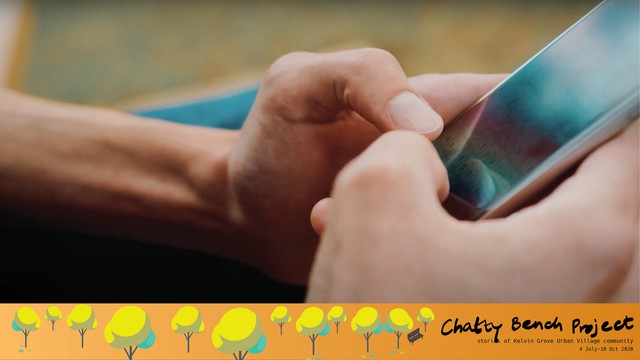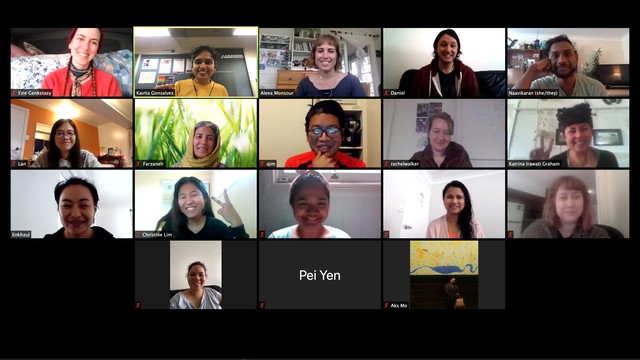Chatty Bench Project: Radical Media Architecture in Precarious Times 2020, Australia, Brisbane
Situated [Story-Place-Media] Making during COVID-19




Instead of catching Pokémons on your smartphone, you catch the stories of KGUV!
Inspired by Pokémon Go, the Chatty Bench Project (CBP) is a radical media architecture where Kelvin Grove Urban Village (KGUV) community members developed place-based digital stories during the COVID-19 pandemic. The situated digital stories are built in the DIY ethos (Caldwell and Foth 2014) using Twine (the interactive fiction tool), include digital media such as images, audios, videos as afforded by mobile phone technology and digitally overlaid over the landscape of KGUV. The term “radical” comes from Radical Placemaking (Gonsalves et al. 2020) which emphasizes Freire’s radical/critical pedagogy where KGUV members collaborate to create digital narratives, Ledwith’s views on community development for environmental and social justice where lived experiences can develop movements of change, and a radical departure from conventional placemaking processes where the intangible of memories, stories and sensemaking, are embedded into place through digital tools. CBP is a case of ‘radical’ media architecture where local and marginalised communities engage in critical, creative and hybrid placemaking methods to voice place-based issues and advocate for social justice. Thus, the project represents participatory city-making of alternative urban imaginaries. The 16 KGUV storytellers of KGUV engaged in co-creative and participatory workshops and created situated digital stories on themes of migration, seeking asylum, the first day on campus, love of dancing, anxiety, domestic violence, the experience of studying at QUT, racism, and many more. The situated digital stories are completely made by the storytellers and involved them learning digital storytelling and locative technology. The project is situated in the Kelvin Grove Urban Village and uses its many landmarks and places to serve as engagement locations. The project ended with two exhibitions: one in the virtual environment of Mozilla Hubs and in a face-to-face community barbecue. The storytellers spoke of being part of a temporal community during this time of physical isolation, learning new skills, cross-adaptation of their skills and experiencing empowerment in the process. Those who experienced the stories during the exhibitions spoke of their visceral experiences in place through the stories, of an “augmented” connection to the storytellers and an empathetic understanding of social justice issues even if they are personally unaffected by them. This project is inspired by Communify's "Happy-to-Chat" bench (see 'Issues Addressed'), where the bench is not just for sitting and resting but also a place to interact, learn about other community members and build connections. With COVID-19, the project went completely online and the painting of the benches was postponed. The project ran from July-October 2020 on online platforms of Google Classroom, Zoom and Hubs by Mozilla. All the participants and stakeholders first 'met face-to-face' during the community exhibition in October 2020.
https://sites.google.com/urbaninformatics.net/chatty-bench-project
https://www.qut.edu.au/news?id=169748
https://research.qut.edu.au/designlab/projects/chatty-bench-project/
Details
Building or project owner : Communify, Village Church, QUT Design Lab, Kelvin Grove Urban Village Principal Body Corporate, Digital Stories: 16 storytellers
Architecture : Project credits: https://sites.google.com/urbaninformatics.net/chatty-bench-project/chatty-bench-project-team
Project artist/ concept/ design/ planning : Kavita Gonsalves (QUT Design Lab), Professor Marcus Foth (Project advisor/QUT Design Lab), Assistant Professor Glenda Amayo Caldwell (Project Advisor/QUT Design Lab)
Display content/ visuals/ showreel : Project Video: Shila Nassab
Project co-ordination : Cait Wildman (Communify), Sam McGeown (Village Church) & Kavita Gonsalves (QUT Design Lab)
Project sponsor/ support : Kelvin Grove Urban Village Principal Body Corporate, QUT Design Lab
Descriptions
Facade type and geometry (structure) : The facade: Smartphone Screen The screens are connected together with the ephemeral ties of participant stories. 16 participants created 16 stories spread across the neighbourhood of Kelvin Grove Urban Village, Brisbane, Australia.
Urban situation : All the stories can be experienced in the neighbourhood of Kelvin Grove Urban Village. All one needs is a smartphone, internet connection, sunglasses, hat and water bottle.
Participatory architecture & urban interaction
Community or communities involved : The Chatty Bench Project includes 16 storytellers from the community of Kelvin Grove Urban Village.
Host organization : Communify, Village Church, Kelvin Grove Urban Village Principal Body Corporate
Issues addressed : CBP addresses the social isolation experienced before and during the COVID-19 Pandemic. KGUV is a diverse community filled with international students, senior citizens, low-income residents and single parents. Communify, the local community organisation, identified loneliness and social isolation as a key challenge as newly-arrived and existing residents have limited social networks, low English-speaking expertise, and difficulty communicating or engaging effectively. This can affect their access to social capital (friendships) which limits their access to opportunities such as recommendations for jobs, emotional support etc. As one step to encourage social interaction, Communify put a ‘‘Happy to Chat’ sign on a bench outside of their premises to encourage those accessing Communify’s Wi-Fi to speak to one another: where serves as the inspiration for Chatty Bench Project.
Impact : 1. People: The digital stories have the capability of building relationships amongst strangers. It happened in the online making of the stories during COVID-19 and it took place by those who experienced the stories in KGUV: they felt connected to the storytellers and most importantly, KGUV is "a place of breathing and feeling people." 2. Place: Anyone who plays the stories is taken to different parts of KGUV: they experience the place through the eyes of the storyteller, connect it to their own knowledge and memories of the place and create new memory-mashes in the process. The place, thus, has enhanced meaning. 3. Technology: This project contributes to the making of a toolkit for making low-tech AR experiences designed for the smallest, affordable and pervasive media screens: the smartphone. The toolkit is targeted at community organisations and non-profits.
Tools developed : Creating Low-Tech AR for Activism-based Community Storytelling.
Tools used : Hardware: Computer and Smartphone Software: Twine and digital storytelling apps such as audio and video recorder on smartphones.
Next steps : The next step in the project is to augment and eventually paint the benches in participatory workshops with KGUV community members. The aim is that the benches become nodes of live and recorded storytelling: key community members can be found on this bench sharing and telling their stories for other community members to experience. This will done in conjunction with the Chatty Bench Festival where community storytelling is celebrated.
Mediacredits
Chatty Bench Project
Chatty Bench Project
QUT
Kavita Gonsalves
Chatty Bench Project